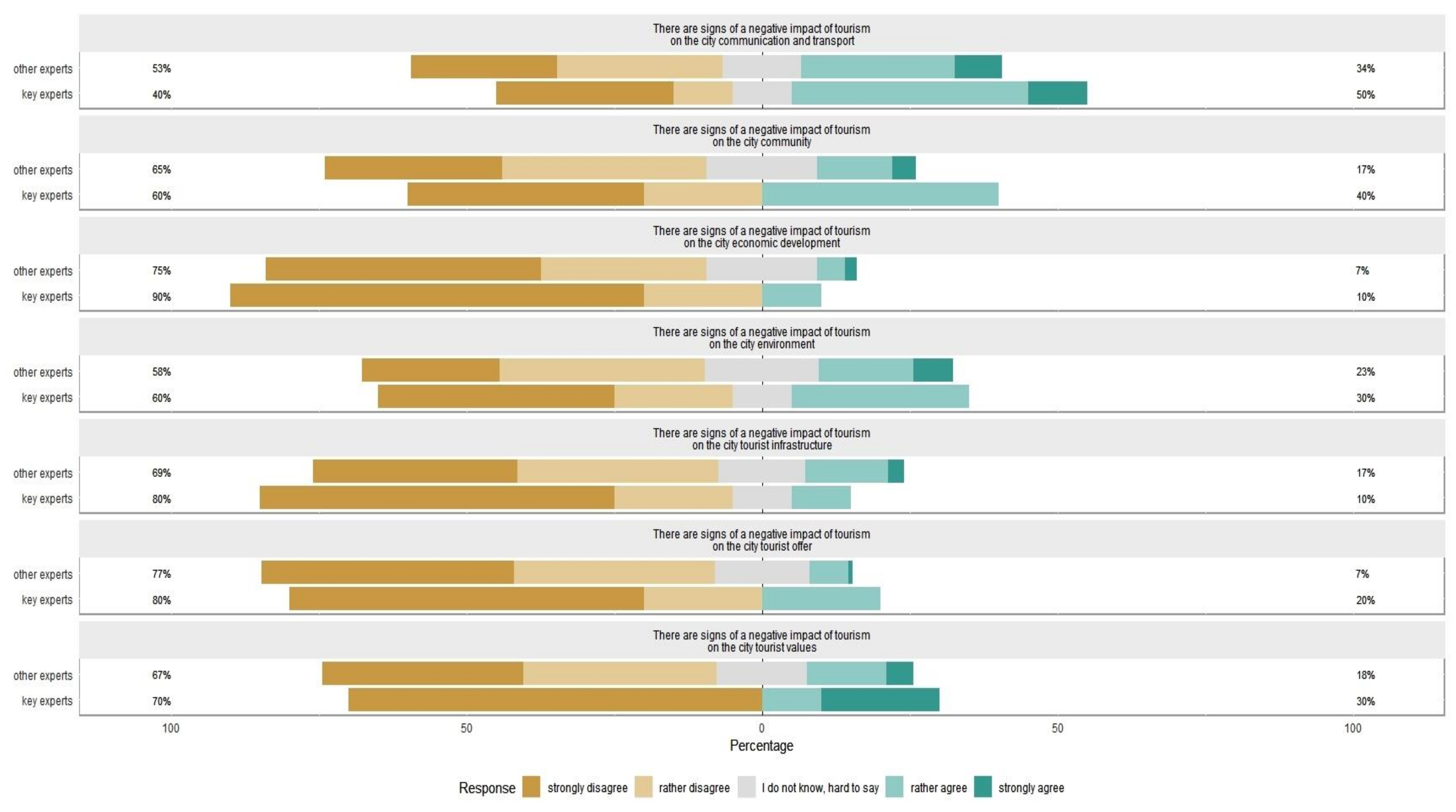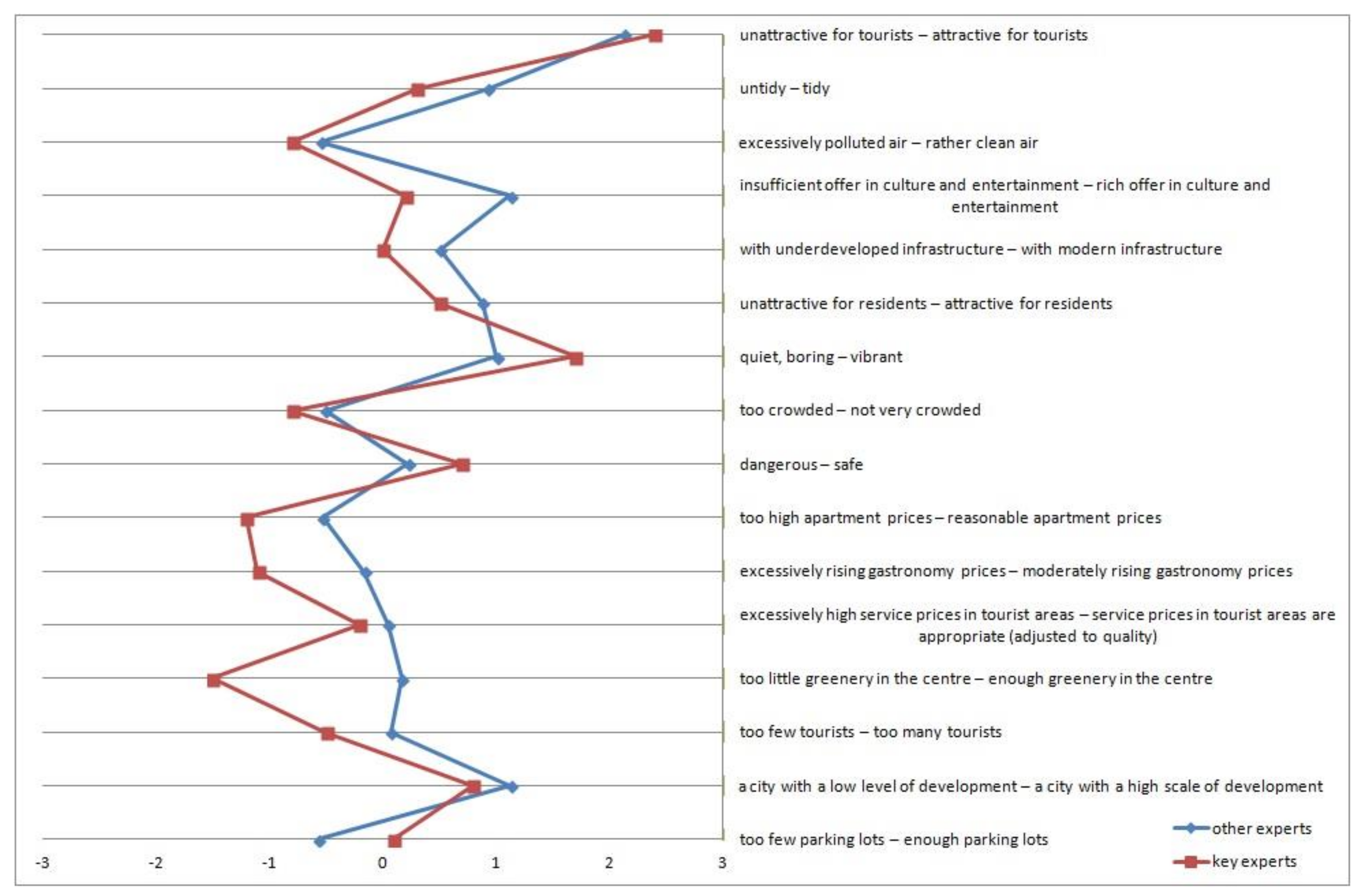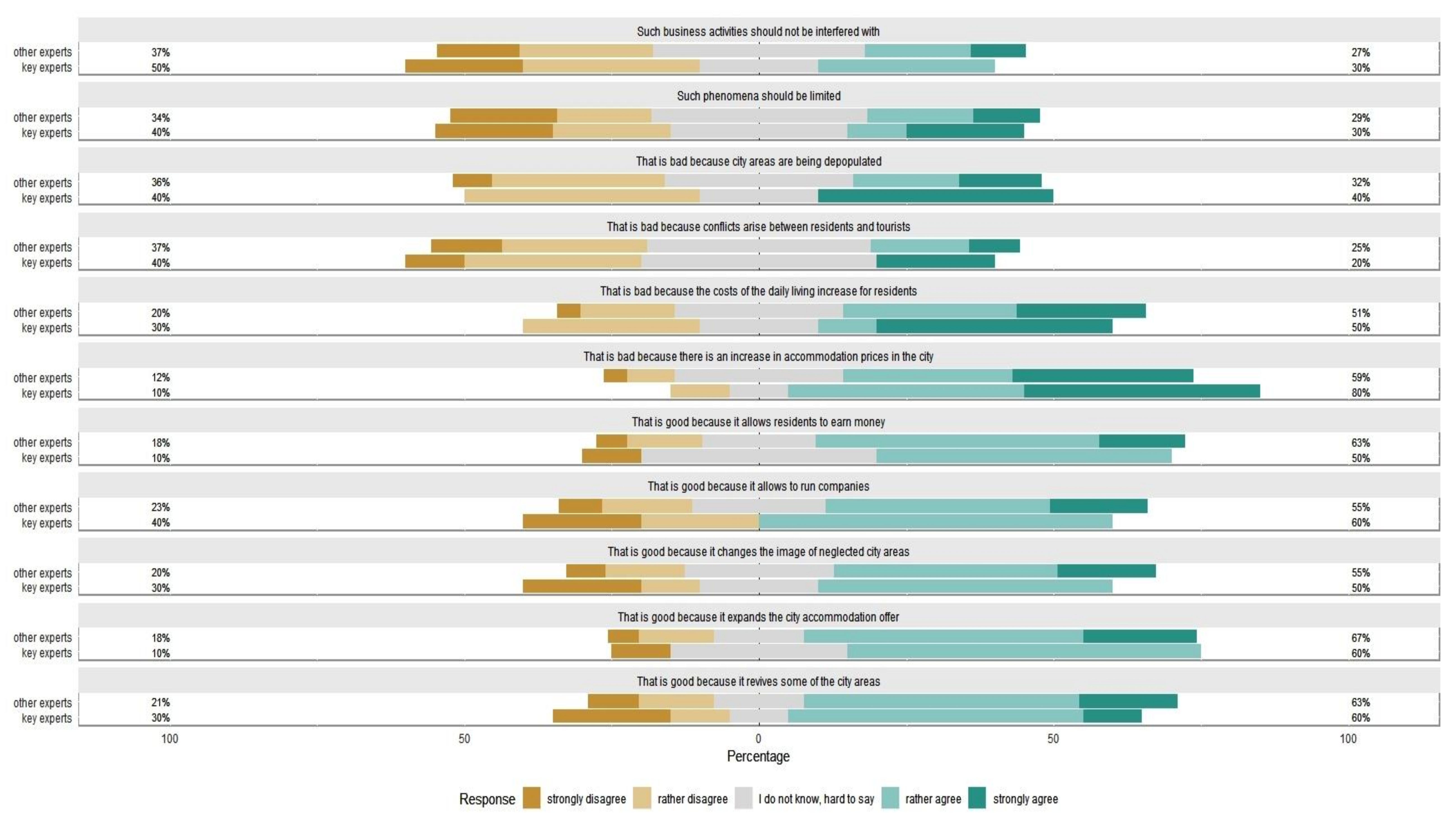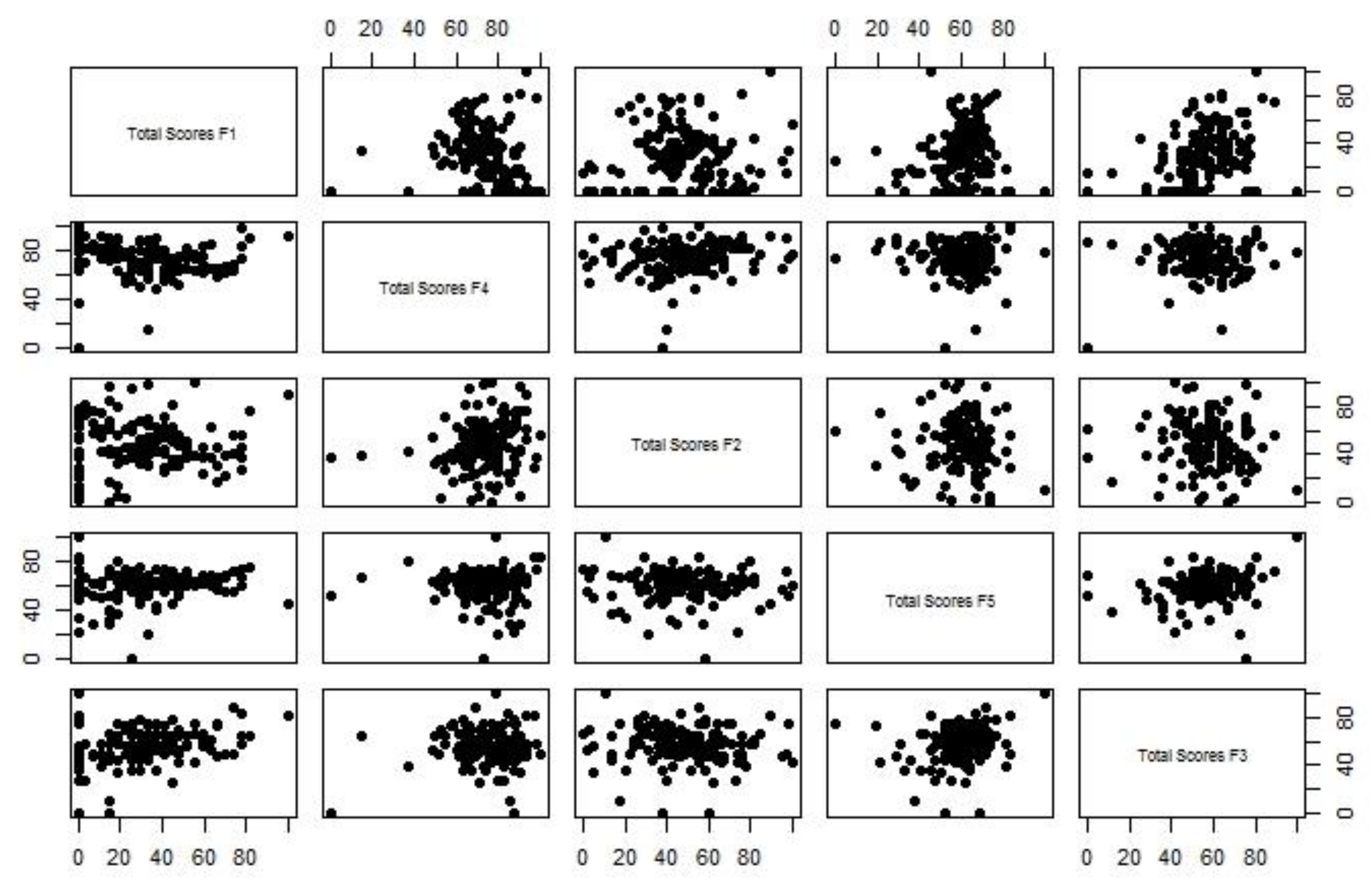How Overtourism Threatens Large Urban Areas: A Case Study of the City of Wrocław, Poland
Abstract
1. Introduction
2. Literature Review
- Cambodia, Costa Rica, US, France, Dubai, Zambia, Sri Lanka, China [31];
- Palma de Mallorca, Paris, Dubrovnik, Kyoto, Bali, Reykjavik, Thailand [25];
- Majorca, Galapagos Islands, Kyoto, Iceland, Costa Rica, Favelas in Rio de Janeiro, Portuguese urban cities, Byron Bay—Australia, Greenland [26];
- Cairo, Delhi, Manila, Bangkok, Moscow [32];
- promote the dispersal of visitors within the city and beyond;
- promote time-based dispersal of visitors;
- stimulate new visitor itineraries and attractions;
- review and adapt regulations;
- enhance visitor segmentation;
- ensure local communities benefit from tourism;
- create urban experiences that benefit both residents and visitors;
- improve city infrastructure and facilities;
- engage and communicate with local stakeholders;
- engage and communicate with visitors;
- establish monitoring and response measures.
3. Material and Methods
- the impact of tourism on the environment, economic development, community, tourist assets and infrastructure, commuting and transport, city tourist offers;
- symptoms of a negative tourist traffic impact on the city space (uneven development of nontourist districts, disparities in the development of districts, pauperisation of nontourist areas);
- tourism features influencing the characteristics of Wrocław;
- the residents’ level of satisfaction with living in Wrocław;
- phenomena related to sharing economy, especially creating an offer for temporary apartment rental in Wrocław;
- the image of the city in the eyes of its residents;
- the phenomenon of moving out of Wrocław or its districts as a result of increased tourist traffic;
- the city’s gentrification processes.
4. Research Results
- commuting and public transport: 50% key experts, 34% other experts (Mpv = 2.66);
- the life of the city community: 40% key experts, 17% other experts (Mpv = 3.25);
- the natural environment of the city: 30% key experts, 23% other experts (Mpv = 2.47);
- the city tourist assets: 30% key experts, 18% other experts (Mpv = 2.21).
- the city tourist infrastructure: 80% key experts, 69% other experts (Mpv = 2.13);
- the city tourist offers: 80% key experts, 77% other experts (Mpv = 2.21);
- the city economic development: 90% key experts, 75% other experts (Mpv = 1.85) (Figure 2).
5. Discussion
- develop a strategy to prevent and reduce overtourism as part of a horizontal city development policy;
- include tourism in the city spatial development plans in an interdisciplinary manner;
- diversify the tourist traffic in the city space, i.e., stimulate tourism in subsequent Wrocław districts (less attractive for tourists than the central area of the city);
- diversify and extend the tourist season to reduce tourist traffic seasonality;
- expand the transport system and urban infrastructure, with strict enforcement of the law with regard to the availability of dedicated spaces for servicing tourist traffic (parking lots, pedestrian routes, etc.);
- develop a local policy for temporary property rental, taking into account a well-balanced tourist offer and respect for the needs of residents;
- moderate the development of tourist services and products in cooperation with businesses and networks, taking care of the quality of services and comfort of both tourists and residents;
- limit acts of vandalism, devastation, aggression in points of contact between tourists and residents through a monitoring system, and the activities of municipal services (municipal guard, police);
- enhance the environmental awareness of tourists, residents, and entrepreneurs.
6. Conclusions
- The tourist development of Wrocław now constitutes a challenge for all tourist traffic stakeholders, including the city authorities. The management of the Wrocław agglomeration, an interesting tourist destination, should focus on finding a concept of sustainable development, using forms of sustainable tourism, and based on measures to prevent or at least mitigate the effects of overtourism. This postulate should also apply to other agglomerations supporting their development through the use of tourism. The tendency of stakeholders to measure success by means of tourism growth [58] is the issue that one should rethink at first while solving the problem of overtourism.
- The threats identified in the study that result from the increased tourist traffic are consistent with those implied in the strategy for the development of tourism in Wrocław, especially with regard to the observed increase in the volume of tourist traffic; concentration of tourist traffic in the city centre, with insufficient use of the potential and resources of other Wrocław regions; growing inefficiency of the transport system (an uncontrolled rise in the number of cars, permanent traffic jamming); growing environmental risks (air pollution, resulting in the discomfort of resting in the city); and the deficit of investments in tourist infrastructure and a modern tourist information system, limiting the tourists’ sense of security [1].
- We point at the need to examine and evaluate the development strategies of other cities with a developed tourist function in Poland and Europe. The aim of such investigations may be to verify the local authorities’ awareness of factors indicating the threat of overtourism in the space of a given city.
- The trends and characteristics of the tourism market observed in urban tourism demand a change of tourism development planning towards a qualitative rather than a quantitative approach. The latter is often misinterpreted as one of the biggest “overtourism enablers” [22], bound with a currently very popular (and lucrative for a few “pockets”) inclination to sustain the tourism growth [59,60].
- The concept of tourism economy development adopted by the Wrocław authorities is focused on maintaining an adequate volume of tourist traffic, changing its structure, extending the length of stay, and reducing seasonality, which would allow for a more sustainable development of the city and for controlling tourism from the position of the city authorities [1]. It is worth mentioning that according to Milano et al. [25], “city administrators and destination managers must acknowledge that there are definite limits to growth. Prioritising the welfare of local residents above the needs of the global tourism supply chain is vital. Prime consideration must be given to ensuring that the level of visitation fits within a destination’s capacity”. In this context, the step that should be taken by the city authorities as part of overtourism prevention and implementation of sustainable development principles in tourism is to define the carrying capacity of Wrocław.
- Besides, it is necessary to emphasize the creation of modern and well-designed public spaces (expansion of tourism beyond the city centre), which would improve the quality of the tourist offer and would effectively address the dangers of excessive concentration of tourist traffic and gentrification phenomena in the city centre. Szromek et al. [55] postulate tourist traffic management that would allow for quick and effective responses to changes, by implementing the concept of agile tourism, defined as adjusting organizational culture and quickly responding to market changes [61].
- There are different levels of knowledge about factors and processes shaping tourist traffic in urban agglomerations. Undoubtedly, we should recommend the need for a broad dialogue among all stakeholders of the tourist traffic regarding the positive and negative tourist factors that affect the city functioning. A broad dialogue of circles making use of tourist traffic and all other inhabitants should become a standard of action in all city entities and should be inspired by the city authorities or the local scientific community.
- The search for synergy of interests among tourism stakeholders should become a priority for the entire tourist environment, by meeting the needs and expectations of residents, who should be fully involved in the development of tourism, along with education that includes the ability to perceive the phenomenon of overtourism and understand it properly. The potential increase (which has been diagnosed in other cities) in conflicts of interest between tourist entrepreneurs and local residents as a result of uncontrolled growth of tourist traffic leads to difficulties in managing the urban agglomeration and may affect the tourist image of the city in the future.
7. Limitations and Further Research
- The research provides an added value as it made it possible to effectively use methodological assumptions in the form of accepted methods of measuring excessive concentration of tourist traffic, with the obvious reservation as to the quantitative scale of the survey—here, the number of respondents.
- The results can be applied as a reference point in further research in the field of overtourism in Wrocław or other cities with a similar scale of tourist traffic and level of attractiveness and with a similar potential of resources serving the development of the sphere of tourism with the application of the sustainable development concept.
- Monitoring tourist traffic from different perspectives should be a strategic challenge and goal for local politicians, managers, researchers, and other stakeholders.
Author Contributions
Funding
Conflicts of Interest
References
- Olearnik, J.; Oleśniewicz, P.; Fedyk, W.; Pluta, J. Koncepcja Rozwoju Turystyki We Wrocławiu Do 2023 Roku; Urząd Miasta Wrocławia: Wrocław, Poland, 2017. [Google Scholar]
- BEELINE Research & Consulting. Badanie Ruchu Turystycznego We Wrocławiu; Urząd Miasta Wrocławia: Wrocław, Poland, 2018. [Google Scholar]
- Opracowanie koncepcji metodologicznej oraz wykonania badań ilościowych i jakościowych ruchu turystycznego na Dolnym Śląsku. Available online: http://www.przetargi.egospodarka.pl/593154_Opracowanie-koncepcji-metodologicznej-oraz-wykonanie-badan-ilosciowych-i-jakosciowych-ruchu-turystycznego-na-Dolnym-Slasku-w-ukladzie-powiatowym_2019_2.html (accessed on 26 February 2020).
- The World According to GaWC 2018. Available online: https://www.lboro.ac.uk/gawc/world2018t.html (accessed on 3 January 2020).
- Premium Brand. Wrocław Miastem z Najwyższą Reputacją–Znamy Wyniki Premium Brand 2019. Available online: http://www.premiumbrand.com.pl/aktualnosci/miasta-2019 (accessed on 3 January 2020).
- IESE. Cities in Motion Index 2019. Available online: https://media.iese.edu/research/pdfs/ST-0509-E.pdf (accessed on 3 January 2020).
- Purvis, B.; Mao, Y.; Robinson, D. Three pillars of sustainability: In search of conceptual origins. Sustain. Sci. 2019, 14, 681–695. [Google Scholar] [CrossRef]
- Buckley, R. Sustainable tourism: Research and reality. Ann. Tour. Res. 2012, 39, 528–546. [Google Scholar] [CrossRef]
- Butler, R.W. Tourism, environment, and sustainable development. Environ. Conserv. 1991, 18, 201–209. [Google Scholar] [CrossRef]
- Butler, R.W. Sustainable tourism: A state-of-the-art review. Tour. Geogr. 1999, 1, 7–25. [Google Scholar] [CrossRef]
- Clarke, J. A framework of approaches to sustainable tourism. J. Sustain. Tour. 1997, 5, 224–233. [Google Scholar] [CrossRef]
- Hardy, A.; Beeton, R.J.S.; Pearson, L. Sustainable tourism: An overview of the concept and its position in relation to conceptualisations of tourism. J. Sustain. Tour. 2002, 10, 475–496. [Google Scholar] [CrossRef]
- Lu, J.; Nepal, S.K. Sustainable tourism research: An analysis of papers published in the Journal of Sustainable Tourism. J. Sustain. Tour. 2009, 17, 5–16. [Google Scholar] [CrossRef]
- Kowalczyk, A. Turystyka Zrównoważona; Wydawnictwo Naukowe PWN: Warszawa, Poland, 2010. [Google Scholar]
- Niezgoda, A. Obszar recepcji turystycznej w warunkach rozwoju zrównoważonego. Prace Habilitacyjne Akad. Ekon. Poznaniu 2006, 24. [Google Scholar]
- Maxim, C. Sustainable tourism implementation in urban areas: A case study of London. J. Sustain. Tour. 2016, 24, 971–989. [Google Scholar] [CrossRef]
- Paunović, I.; Jovanović, V. Implementation of sustainable tourism in the German Alps: A case study. Sustainability 2017, 9, 226. [Google Scholar] [CrossRef]
- Rodrigues, A.L.O.; Rodrigues, A.; Peroff, D.M. The sky and sustainable tourism development: A case study of a Dark Sky Reserve implementation in Alqueva. Int. J. Tour. Res. 2015, 17, 292–302. [Google Scholar] [CrossRef]
- Rutty, M.; Richardson, R.B. Tourism research in Cuba: Gaps in knowledge and challenges for sustainable tourism. Sustainability 2019, 11, 3340. [Google Scholar] [CrossRef]
- Gołembski, G. Kompendium Wiedzy o Turystyce, 2nd ed.; Wydawnictwo Naukowe PWN: Warszawa, Poland, 2009. [Google Scholar]
- Niezgoda, A.; Markiewicz, E. Turystyka biznesowa a turystyka zrównoważona – przykład hotelu w aglomeracji. Zesz. Nauk. WSB Pozn. 2015, 63, 226–240. [Google Scholar]
- Dodds, R.; Butler, R.W. Overtourism: Issues, Realities and Solutions; De Gruyter: Berlin, Germany, 2019. [Google Scholar]
- Dredge, D. “Overtourism” Old Wine in New Bottles? Available online: https://www.linkedin.com/pulse/overtourism-old-wine-new-bottles-dianne-dredge (accessed on 6 December 2019).
- Kruczek, Z. Ways to counteract the negative effects of overtourism at tourist attractions and destinations. Ann. Univ. Mariae Curie Sklodowska B Geogr. Geol. Miner. Petrogr. 2019, 74, 45–57. [Google Scholar] [CrossRef]
- Milano, C.; Cheer, J.M.; Novelli, M. Overtourism: A Growing Global Problem. 2018. Available online: https://sg.news.yahoo.com/overtourism-growing-global-problem-120301587.html (accessed on 3 January 2020).
- Milano, C.; Cheer, J.M.; Novelli, M. Overtourism: Excesses, Discontents and Measures in Travel and Tourism; CABI: Boston, MA, USA, 2019. [Google Scholar]
- Séraphin, H.; Zaman, M.; Olver, S.; Bourliataux-Lajoinie, S.; Dosquet, F. Destination branding and overtourism. J. Hosp. Tour. Manag. 2019, 38, 1–4. [Google Scholar] [CrossRef]
- Milano, C. Overtourism and Tourismphobia: Global Trends and Local Contexts; Ostelea School of Tourism & Hospitality: Barcelona, Spain, 2017. [Google Scholar]
- World Tourism Organization (UNWTO). Overtourism?–Understanding and Managing Urban Tourism Growth beyond Perceptions, Executive Summary. Available online: https://www.unwto.org/global/publication/overtourism-understanding-and-managing-urban-tourism-growth-beyond-perceptions-executive (accessed on 26 February 2020).
- The International Ecotourism Society. Ecotourism Is the Solution to Overtourism. 2019. Available online: https://ecotourism.org/news/ecotourism-is-the-solution-to-overtourism/ (accessed on 3 January 2020).
- Becker, E. Overbooked. In The Exploding Business of Travel and Tourism; Simon & Schuster: New York, NY, USA, 2013. [Google Scholar]
- World Travel and Tourism Council. Destination 2030: Global Cities’ Readiness for Tourism Growth. Available online: https://www.wttc.org/publications/2019/destination-2030/ (accessed on 3 January 2020).
- Kruczek, Z. Turyści vs Mieszkańcy. Wpływ Nadmiernej Frekwencji Turystów na Proces Gentryfikacji Miast Historycznych na Przykładzie Krakowa. Available online: http://turystykakulturowa.org/ojs/index.php/tk/article/view/956 (accessed on 26 February 2020).
- Gretzel, U.; Fesenmaier, D.R.; Formica, S.; O’Leary, J. Searching for the future: Challenges faced by destination marketing organizations. J. Traval Res. 2006, 45, 116–126. [Google Scholar] [CrossRef]
- Klimek, K. Destination management organisations and their shift to sustainable tourism development. Eur. J. Tour. Hosp. Recreat. 2013, 4, 27–47. [Google Scholar]
- Müller, H.; Berger, P. Benchmarking for destination management organizations: The case of Swiss cities and Alpine destination management. Tour. Rev. 2012, 67, 26–39. [Google Scholar] [CrossRef]
- Pike, S. Consumer-based brand equity for destinations. J. Travel Tour. Mark. 2007, 22, 51–61. [Google Scholar] [CrossRef]
- Pike, S.; Page, S.J. Destination marketing organizations and destination marketing: A narrative analysis of the literature. Tour. Manag. 2014, 41, 202–227. [Google Scholar] [CrossRef]
- Presenza, A.; Sheehan, L.; Ritchie, J.R.B. Towards a model of the roles and activities of destination management organizations. J. Hosp. Tour Leis. Sci. 2005, 3, 1–16. [Google Scholar]
- Zins, A.H. Internal benchmarking for regional tourism organizations: A case example. Tour. Anal. 2014, 19, 413–424. [Google Scholar] [CrossRef]
- Kowalczyk, A. Od turystyki 3S do turystyki 3E. In Turystyka Wobec Zmian Współczesnego Świata. Zmiany, Bariery, Innowacje; Gołembski, G., Niezgoda, A., Eds.; Wydawnictwo Uniwersytetu Ekonomicznego w Poznaniu: Poznań, Poland, 2014. [Google Scholar]
- Balińska, A.; Sieczko, A.; Zawadka, J. Turystyka: Wybrane zagadnienia; Difin: Warszawa, Poland, 2014. [Google Scholar]
- Wearing, S.; McGehee, N.G. International Volunteer Tourism: Integrating Travellers and Communities; CABI: Boston, MA, USA, 2013. [Google Scholar]
- Fennell, D.A. Ecotourism; Routledge: Abingdon, UK, 2015. [Google Scholar]
- Wearing, S.; Schweinsberg, S. Ecotourism: Transitioning to the 22nd Century; Routledge: Abingdon, UK, 2018. [Google Scholar]
- Fischer, A. Sustainable Tourism; UTB GmbH: Bern, Switzerland, 2014. [Google Scholar]
- Zaręba, D. Ekoturystyka, 3rd ed.; Wydawnictwo Naukowe PWN: Warszawa, Poland, 2010. [Google Scholar]
- Galar, R.; Roman, G.; Waszkiewicz, J. Strategia, Wrocław w perspektywie 2020 plus; Urząd Miasta Wrocławia: Wrocław, Poland, 2006. [Google Scholar]
- Strategia Wrocław 2030. Available online: https://www.wroclaw.pl/rozmawia/strategia-wroclaw-2030 (accessed on 3 December 2019).
- R Core Team. R: A Language and Environment for Statistical Computing. Available online: https://www.r-project.org/ (accessed on 26 February 2020).
- Bryer, J.; Speerschneider, K. Likert: Analysis and Visualization Likert Items. 2016. Available online: https://rdrr.io/cran/likert/ (accessed on 26 February 2020).
- Peeters, P.; Gössling, S.; Klijs, J.; Milano, C.; Novelli, M.; Dijkmans, C.; Eijgelaar, E.; Hartman, S.; Heslinga, J.; Isaac, R.; et al. Research for TRAN Committee–Overtourism: ćImpact and Possible Policy Responses; European Parliament, Policy Department for Structural and Cohesion Policies: Brussels, Belgium, 2018. [Google Scholar]
- Walas, B. Turystyczny Najem Krótkoterminowy w Ocenie Interesariuszy Lokalnych. Available online: http://journals.pan.pl/Content/115435/PDF/049_062_Walas.pdf?handler=pdf (accessed on 3 February 2020).
- Innerhofer, E.; Erschbamer, G.; Pechlaner, H. Overtourism: The Challenge of Managing the Limits. In Overtourism: Tourism Management and Solutions; Pechlaner, H., Innerhofer, E., Erschbamer, G., Eds.; Routledge: New York, NY, USA, 2019. [Google Scholar]
- Szromek, A.R.; Kruczek, Z.; Walas, B. The attitude of tourist destination residents towards the effects of overtourism–Kraków case study. Sustainability 2019, 12, 228. [Google Scholar] [CrossRef]
- Kowalczyk-Anioł, J.; Zmyślony, P. Turystyka miejska jako źródło protestów społecznych: Przykłady Wenecji i Barcelony. Kowalczyk Anioł Piotr Zmyślony 2017, 2, 7–36. [Google Scholar]
- Gnieźnieńskie Forum Ekspertów Turystyki Kulturowej. Overoturism w Turystyce Kulturowej. Available online: www.turystykakulturowa.org (accessed on 19 February 2020).
- Becken, S.; Simmons, D.G. Stakeholder Management: Different Interests and Different Actions. In Overtourism: Issues, Realities and Solutions; Dodds, R., Butler, R., Eds.; De Gruyter: Berlin, Germany, 2019. [Google Scholar]
- Higgins-Desbiolles, F. Sustainable tourism: Sustaining tourism or something more? Tour. Manag. Perspect. 2018, 25, 157–160. [Google Scholar] [CrossRef]
- Monbiot, G. How “Sustainability” Became “Sustained Growth”. 2012. Available online: https://www.monbiot.com/2012/06/22/how-sustainability-became-sustained-growth/ (accessed on 20 February 2020).
- Cheer, J.M.; Lew, A. Understanding Tourism Resilience: Adapting to Social, Political, and Economic Change. In Tourism, Resilience, and Sustainability: Adapting to Social, Political and Economic Change; Cheer, J.M., Lew, A., Eds.; Routledge: Abingdon, UK, 2017; Available online: https://www.researchgate.net/publication/319059213_Understanding_tourism_resilience_Adapting_to_social_political_and_economic_change (accessed on 3 February 2020).







| Wrocław Residents | |
|---|---|
| Permanent residence | 20.00% |
| City of professional activity | 15.00% |
| City of residence and work | 65.00% |
| Age | |
| 15–24 years | 46.25% |
| 25–44 years | 16.25% |
| 45–64 years | 25.62% |
| ≥65 years | 11.88% |
| Type of Activity | |
| Tourist traffic organization and services | 52.50% |
| Hospitality services | 6.25% |
| Catering | 8.75% |
| Transportation services | 4.38% |
| Other tourist services | 26.88% |
| Other services | 1.25% |
| Figure 1 Scores | Figure 4 Scores | Figure 2 Scores | Figure 5 Scores | Figure 3 Scores | |
|---|---|---|---|---|---|
| F1 scores | 1.00 | −0.30 | −0.09 | 0.15 | 0.30 |
| F4 scores | −0.30 | 1.00 | 0.32 | 0.00 | −0.09 |
| F2 scores | −0.09 | 0.32 | 1.00 | −0.12 | −0.15 |
| F5 scores | 0.15 | 0.00 | −0.12 | 1.00 | 0.27 |
| F3 scores | 0.30 | −0.09 | −0.15 | 0.27 | 1.00 |
© 2020 by the authors. Licensee MDPI, Basel, Switzerland. This article is an open access article distributed under the terms and conditions of the Creative Commons Attribution (CC BY) license (http://creativecommons.org/licenses/by/4.0/).
Share and Cite
Fedyk, W.; Sołtysik, M.; Olearnik, J.; Barwicka, K.; Mucha, A. How Overtourism Threatens Large Urban Areas: A Case Study of the City of Wrocław, Poland. Sustainability 2020, 12, 1783. https://doi.org/10.3390/su12051783
Fedyk W, Sołtysik M, Olearnik J, Barwicka K, Mucha A. How Overtourism Threatens Large Urban Areas: A Case Study of the City of Wrocław, Poland. Sustainability. 2020; 12(5):1783. https://doi.org/10.3390/su12051783
Chicago/Turabian StyleFedyk, Wojciech, Mariusz Sołtysik, Janusz Olearnik, Katarzyna Barwicka, and Anna Mucha. 2020. "How Overtourism Threatens Large Urban Areas: A Case Study of the City of Wrocław, Poland" Sustainability 12, no. 5: 1783. https://doi.org/10.3390/su12051783
APA StyleFedyk, W., Sołtysik, M., Olearnik, J., Barwicka, K., & Mucha, A. (2020). How Overtourism Threatens Large Urban Areas: A Case Study of the City of Wrocław, Poland. Sustainability, 12(5), 1783. https://doi.org/10.3390/su12051783





